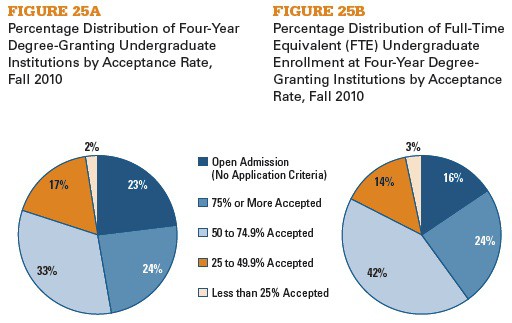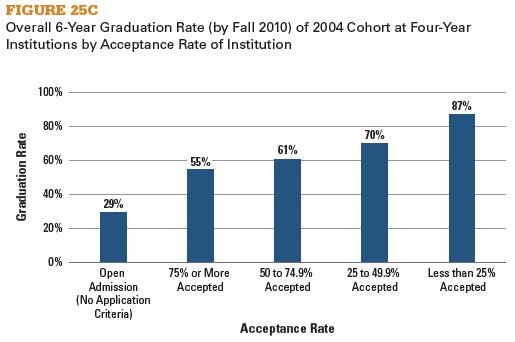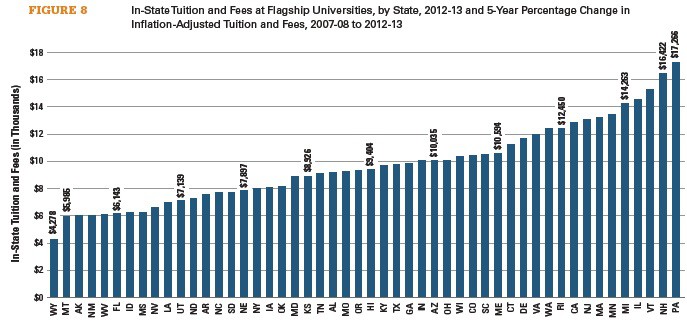
Do you assume that most teenagers face lousy odds of getting accepted into a good college?
Lots of families believe that the admission process is stacked heavily against applicants, but this isn’t true. I largely blame the media’s obsessive coverage of the most elite universities for that misconception.
A report from the College Board, Trends in College Pricing 2012, clearly dispels the notion that colleges are impenetrable fortresses that turn away nearly all who dare apply.
If you look at the pie chart below, you’ll see that nearly half of all four-year colleges and universities accept all comers or at least 75% of its applicants.
Only 2% of institutions accept less than 25% of their applicants. These 60 elite schools (out of 2,421) educate just 3% of the nation’s full-time undergrads who are attending four-year institutions.
College & University Acceptance Rates
College & University Graduation Rates
There is a price to pay, however, for students who attend less selective schools. The more exclusive a college or university is, the greater the chance of graduation. I’d argue that the graduation rates at more exclusive schools have far less to do with the institutions and more to do with the kind of students they attract.
Only 29% of full-time students who began at open-admission institutions in 2004 and 55% of those who began at institutions accepting at least 75% of their applicants earned degrees at their first institutions within six years.
Most Expensive and Cheapest Flagships
While people assume that their state universities will always be cheaper than private schools that is not always the case when financial aid and scholarships are factored in. What many people don’t realize is that a wide variety of prices exist among state universities.
Among public flagship universities in the 50 states, Penn State has the dubious honor of charging the highest price for tuition and fees ($17,266) and the University of New Hampshire isn’t far behind. In contrast, the University of Wyoming charges the lowest ($4,278) followed by the University of Montana. (Sorry this graphic spilled over, but if I minimized it, it would be even harder to read.)
Average Net Price at State Universities
During the past five years, average published tuition and fees at public four-year institutions increased by $1,850 (in 2012 dollars) from $6,810 to $8,660. About $1,410 of this increase was covered by increases in grant aid from all sources and federal tax credits and deductions.
The average net tuition price for the 2012-2013 school year, after grants and tax breaks were deducted, was $2,910. With room and board of $9,200, the average net price was $12,110.
Average Net Price at Private Institutions
The average net tuition and fees for private schools (after subtracting grants from all sources and tax credits) was an estimated $13,380 for the 2012-2013 school year. For this school year, full-time students at private colleges and universities received an estimated $15,680 in grant aid and tax benefits. When you add in the typical room and board charges of $10,460, the total net price was $23,840.
Cutting the Cost of College
Now that you know what college prices are like, read below for a few suggestions on how to shrink your costs:
Why Saving for College Won’t Hurt Your Financial Aid Chances
Playing Hide and Seek with Net Price Calculators
College Cost Calculators: Getting Wildly Different Answers
Qualifying for Financial Aid: How Wealthy Is Too Wealthy?
Lynn O’Shaughnessy is the author of The College Solution and




Does the two percent also include low-priced schools in New York? The better CUNY and SUNY schools accept less than 40 percent of all applicants, in large part because tuition and fees are very low and the volume of applications, given the number of college-bound students in New York, is so high. However, aside from CUNY-Baruch, SUNY-Binghamton University and SUNY-Geneseo, these schools do not have exceptional retention or graduation rates.
Hi Stuart,
You would have to ask the College Board that question, but I don’t know why these schools would not be included in that 2 percent.
Lynn O’Shaughnessy
This is encouraging – the media does seem to enjoy inflating worries, but then that’s what they excel at in general. 🙂